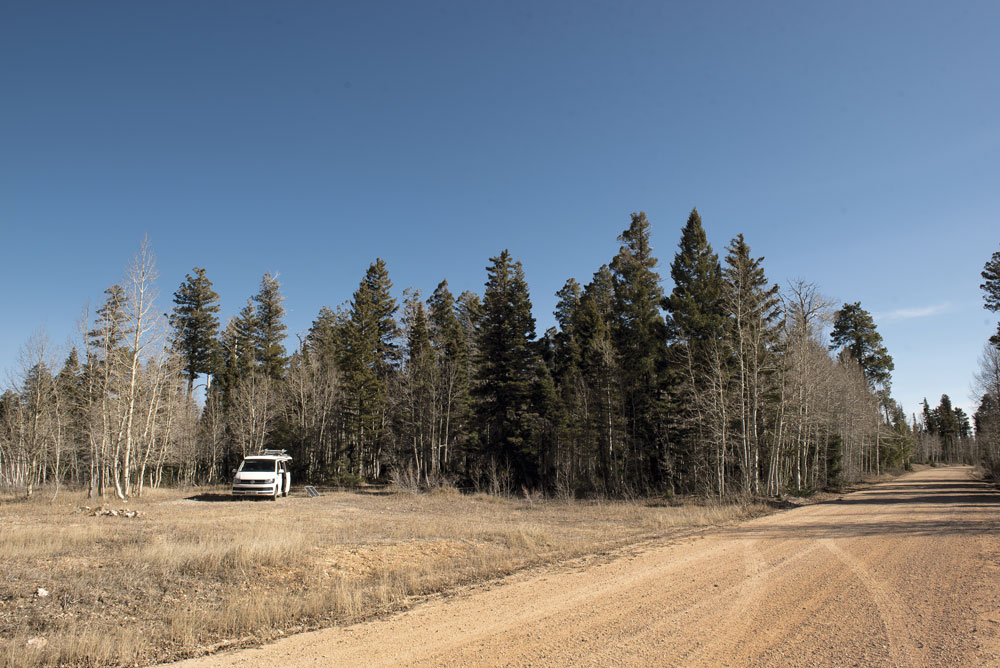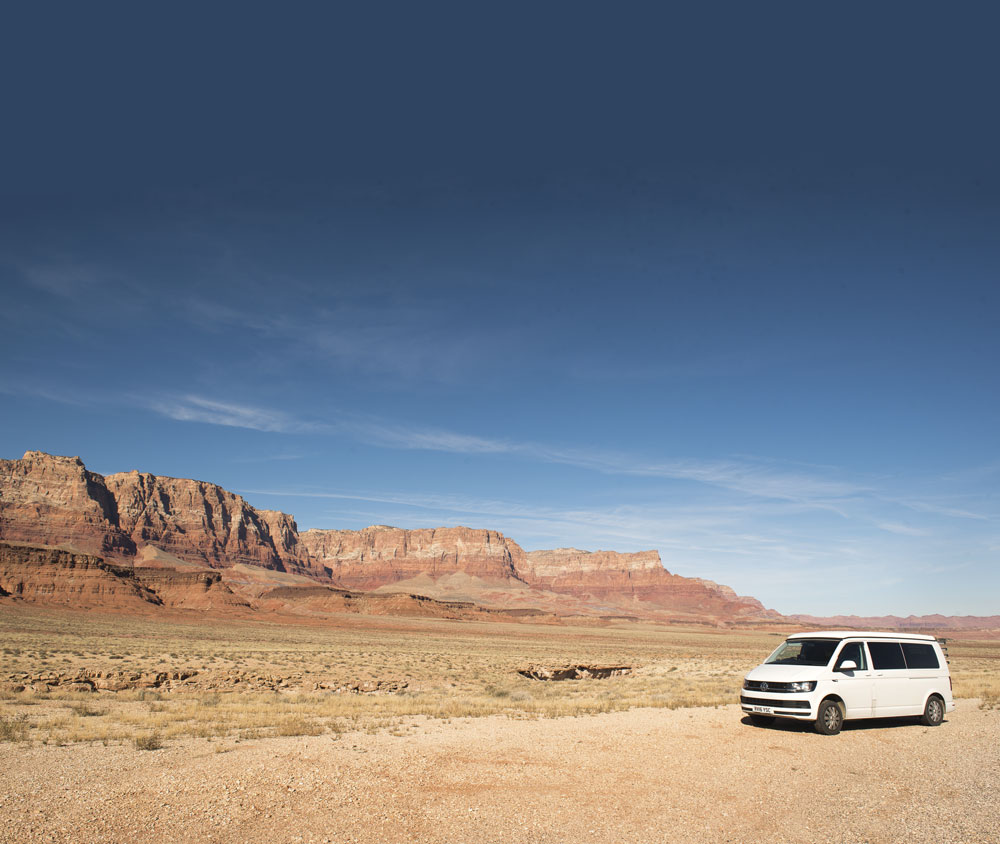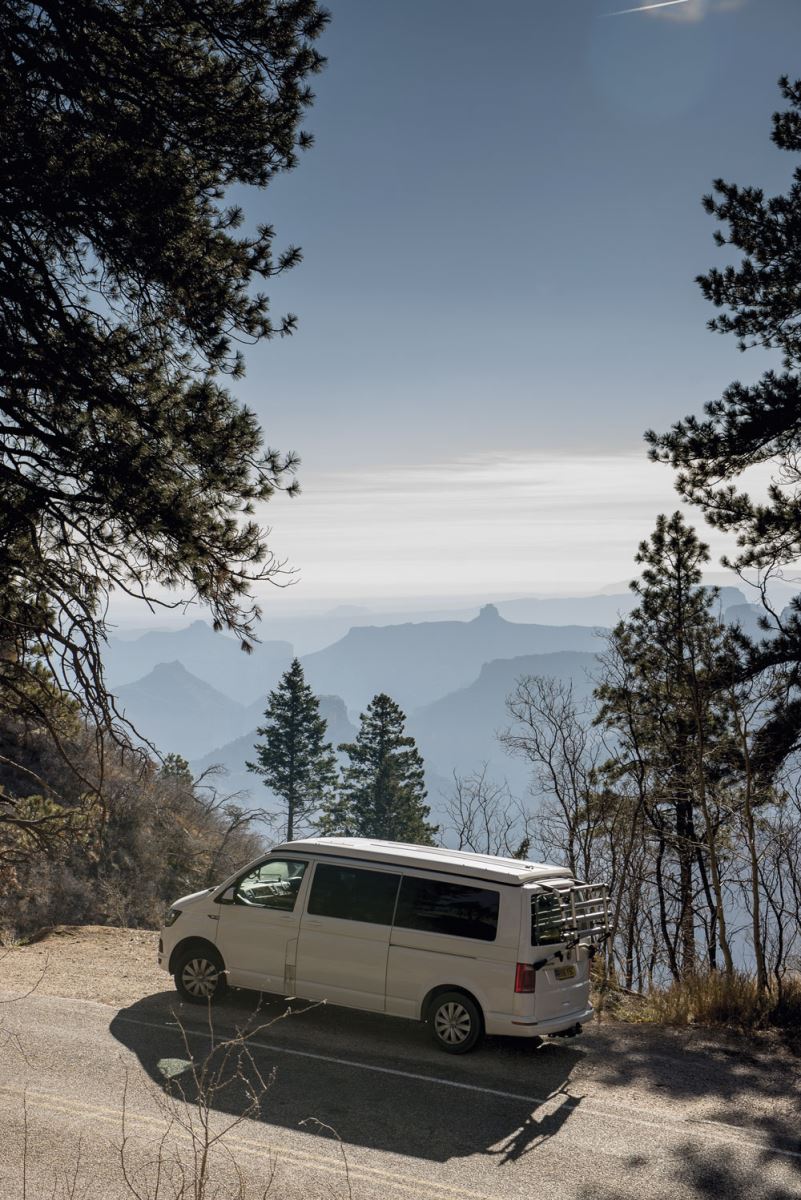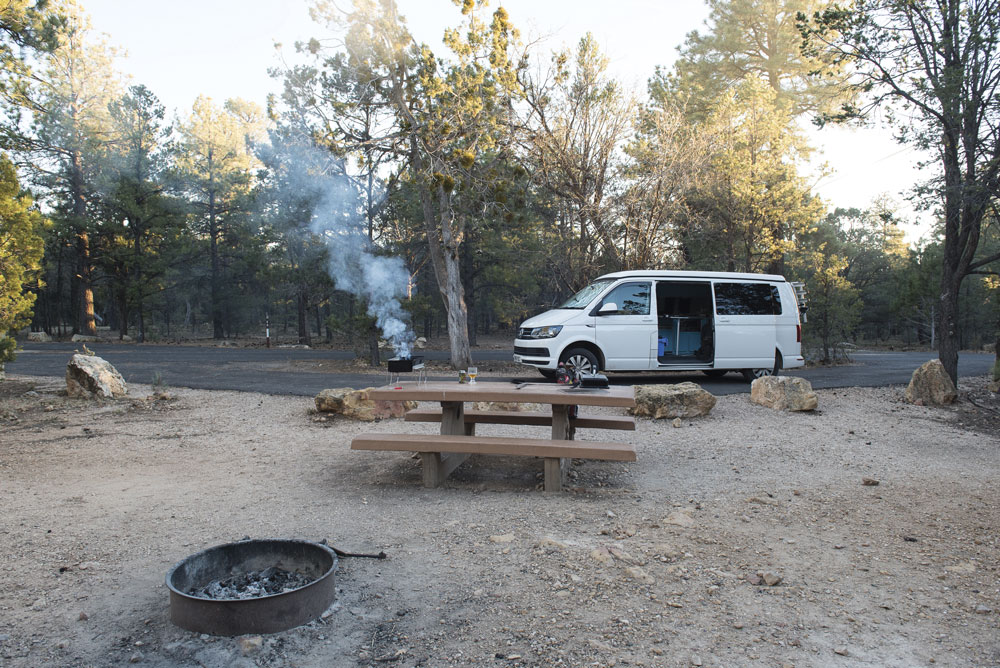Grand Canyon adventures in a campervan
See also: Campervan: Travel and Destination Guide
Words and photos by Mike Waterman
The place that makes me feel most insignificant, both in terms of scale and time, is the Grand Canyon. Every vista shows a vastness and majesty of scale guaranteed to make the viewer look and feel tiny. The fact it took six million years to create and has exposed rock at its base, which is over 1,700 million years old, really does mean the era of modern man is just a blink of an eye to such a venerable landmark. And, if that’s the case, where does that leave little old me in the grand scale of things?
As is my preference for travelling, I visited the Arizona-based national park out of season, in early winter. Whenever possible I like to avoid the crowds. The most popular area for visitors is the South Rim. Approaching from the south on US 64, the growing anticipation is slightly dulled by the town of Tusayan, only seven miles from the South Rim – this is a typical tourist centre, chock full of motels, hotels and fast food outlets. When expecting a 277-mile long, one-mile deep canyon, it was a bit of a shock to hit such commercialism so close!

There is an RV Park in Tusayan, the Grand Canyon Camper Village, but I wanted to be based in the Park itself. The entrance fee for the Grand Canyon National Park is $35 (£28) per vehicle, which covers seven days, making the Grand Canyon one of the more expensive national parks to visit in the USA.
However, if you plan on shipping your camper to the States to spend an extended period of time here, as I’m currently doing, it’s worth bearing in mind that an annual pass covering all national parks and national monuments is only $80 (£65) for two people. Simply ask for an ‘America The Beautiful’ card at any park visitor centre or pay booth.
At the South Rim, there are two camping options, both next door to each other and both within walking distance of the Grand Canyon. For those who must have an electric hook-up, Trailer Village is the place. Mather Campground is the alternative and, unlike the concessionary RV park next door, is run by the National Park Service.
It’s a lovely forested location, with pitches spread out. There are toilet blocks but no showers or electricity and, in winter, the water supply is turned off. Each pitch has a fire ring and a large picnic table. It’s where I headed and I think is great value for $18 (£14.50) per night.
Close by is Grand Canyon Village, where there is a well-stocked supermarket, reasonably sized and not as overpriced as I would have expected in such a situation. Everything in the park is quite spaced out, the visitor’s centre is located about a mile from the village. Shuttle buses are provided, which follow three coloured routes.
It’s very feasible to leave the camper in the campground, walk to the nearest bus stop and spend the whole time being driven around. The alternative is to take your campervan to the various viewing points, although some areas are only available to those walking or on the bus. I ended up with a combined approach.
Where it was permitted, I drove, as I had a lot of photographic gear and it was an excuse to help keep the 'van’s batteries charged. I used the bus service for those areas where my camper was not allowed.
A very grand canyon
It’s a very strange experience first seeing the Grand Canyon. The approach gives very little away to the world. I drove to the visitor centre car park and followed one of the various paths signposted to the South Rim. Moments later it was suddenly before me. It just appears in its full glory, without any warm-up. One minute I was walking along a path, which could be in any old city park and the next I’m standing on the edge of a sight that really does take the breath away!

It’s worth knowing that the canyon sits at a reasonable altitude, a fact I hadn’t really clued into before my visit. The campsite is at over 2,000 metres, setting a comparable scale by remembering Ben Nevis tops out at 1,345 metres. I guess if a river can erode a gorge a mile deep and still be running downhill to the Gulf of California in Mexico, it makes sense that it had to start from a high place.
The point is, at over 2,000 metres, it can get a bit chilly in winter. For my visit the weather was sunny during the day, warming to just double-figure degrees on some days. I cooked on my barbecue every evening, which was fine when equipped with a hat and coat. The worst part was early morning, when it was coldest.
My Eberspächer heater chose this time to play up and the coldest the campervan was when I woke up was minus three degrees. That said, as soon as I’d made the first cup of coffee and the sun hit the windows, all was well again. Warm clothes and warm bedding were the order of the day, although I could hardly grumble as there were quite a few Americans in tents.
Following the Rim Trail on the Grand Canyon
The shuttle buses cover approximately 11 miles of the South Rim from Yaki Point in the east to Hermits Rest in the west. Most of that distance can also be walked by following the Rim Trail. In addition, there is another 20 miles of road with various viewing points heading further east to Desert View, which is at the eastern edge of the park. This portion is only available to private vehicles and is also the first part of the trip to the North Rim.

At its widest the Grand Canyon is 18 miles. From the South Rim, the North Rim is easily visible. In fact, it is very easy to spot the exact location of the park facilities over there by just following the line of the Bright Angel Trail.
It is this geological fault which provides the route for the 23-mile hiking trail that crosses from rim to rim. However, by vehicle it’s a 212-mile round trip and the National Park Service warns it’s a four-and-a-half hour trip. It took me eight hours with photo stops.
The drive is worth it in its own right. It skirts the southern and then the eastern edges of the canyon with viewing points over the Little Colorado River.
This is Navajo Indian country and should you wish to purchase pottery and jewellery, the countless roadside stalls will gladly fulfil the need.
Further north the route heads along the Vermilion Cliffs, which are sufficiently spectacular to be declared a National Monument and are so different in style to the Grand Canyon.
Finally, it's south through forested areas with windy roads to the North Rim. In terms of visitor numbers, the North Rim is the poor relation to the South. This is reflected in the fact that, in winter, everything there is closed. The campsite, the lodge, the cabins, even the entrance booth, are all shut up to business. Access to the rim, however, is still open.
The views from the North Rim are different to the South. It’s higher for a start, so in places it looks down on the south and therefore beyond to the flat landscape behind the canyon. The light provides different effects as the sun shines from the opposite bank, backlighting the scene, and I also thought the landscape was a little more varied.
The star for me was the Cape Royal Road, a scenic route circling round to the east. It offers several outlooks spread over the 20-mile length, all with stunning views, many of which face east. These include Point Imperial, the highest viewpoint in the park at 2,683 metres and Angels Window, a hole in a rock outcrop through which the Colorado River can be spotted.
The South Rim was relatively quiet, but still felt busy in places, particularly late morning until mid-afternoon. The North Rim by comparison was deserted. I found that because we visitors were so few and had all made quite an effort to visit the location, there was lots of chatting and comparing of notes as we ran into each other at various outlooks. Interestingly, the majority seemed to be from Europe rather than America.
Most were in hired RVs, campervans or cars, mainly out of Los Angeles, although for a shorter visit Las Vegas would offer a closer place to start.
I’d visited the South Rim Backcountry office and asked about camping in the north, bearing in mind the park’s campground was closed for the season. Surrounding the park is the Kaibab National Forest and, like many national forests, free dispersed camping is allowed all over it. Simply take a side road and find a spot. I camped for three nights in three different areas. Every pitch I found had evidence of previous campers, with stone fire rings littering the place.
My learning from my trip, even without doing the multi-day hike down into the Grand Canyon to see the Colorado River at close hand, was that the two rims take a lot of seeing. I was there for a week and could have done longer. It’s well worth hiking down into the canyon, even if it’s only for a couple of hours each way.
Judging by the scale of the car parks in the south, I wouldn’t want to visit in high season. The North Rim was easily my favourite and, even though it’s a bit of a trip, that drive is also a highlight.

Top Tips from Worldwide Motorhoming Holidays
The staff at the Camping and Caravanning Club know a thing or three when it comes to planning epic road trips in the USA, so we asked them for their top tips on exploring the Grand Canyon by campervan.
“Driving is a pleasure in the USA as the roads are wider, there are no ring roads and some of the views are spectacular! Hiring an RV makes for a fantastic way to travel, as it gives you the freedom to go as you please and discover at your leisure, of course.”
“When packing for your trip, take lots of layers including hats and gloves as it can get really cold at night. And make sure you get up early to see the sun rise over the canyon! It’s such a fantastic experience and, again, at sunset – the amazing views will not fail to impress you.”
“While you’re there, take advantage of the cycle hire at the visitor centre. It’s a fantastic way to explore. There are plenty of hikes and walks, too, and regular free buses that will take you all round the Grand Canyon.”
“If planning isn’t your strong suit then why not join our 37-day Western Adventure Escorted Tour? It includes a visit to the spectacular Grand Canyon as well as Zion and Bryce Canyons. Or our Travel Specialists can help you plan your own tailor-made campervan adventure.”
This trip took place prior to the coronavirus pandemic. We are publishing it for your enjoyment and to help you plan your future trips. Read the latest camping travel advice here.
Expert Campervan advice to your door!
Campervan is the exciting monthly magazine that will give you all the inspiration you need to explore the world in your campervan. Every issue is packed with real-life campervanning experiences, inspiring travel ideas in the UK and further afield, the best campsites to stay on, campervan road tests and reviews of the latest models, and much more!
Want to know more about Campervan Magazine?








Recent Updates
Engine management lights: all you need to know
What is the engine management light? What does it mean, and what do I have to do? ...
Motorhome air suspension: all you need to know
Motorhomes are heavy and the additional weight of equipment and height of the bodywork can increase the loads ...
Motorhome WiFi: how to get better motorhome internet
Staying connected on the move is more and more essential, so relying on campsite WiFi isn't an option – here ...
A class of their own - our guide to A-class motorhomes
Thinking of trading up to an A-class, or even going straight to the top of the motorhome tree? We guide you ...
Explore overseas on a motorhome dream tour
Enjoy exotic travel in a campervan or motorhome by hiring, swapping with someone else or exporting your ...
Motorhome water systems: everything you need to know
On-board water is an important part of every motorhome – here’s everything you need to know ...
Campervanning in Europe: what you need to know
Whether you're planning a leisurely drive through the French countryside, navigating bustling city streets in ...
Campervan security: all you need to know
With thefts on the increase, it’s important to know how to keep your campervan secure and prevent campervan ...
Campervan furniture: everything you need to know
Our campervan experts guide you through all the essentials for your campervan, including tables, chairs, ...
Campervan finance: how to fund your purchase
Here we look at the different types of campervan finance available, to help you decide what’s the best option ...
Other Articles
Britain’s best used motorhomes
Want a great motorhome without paying the premium for a new one? Here's a guide to the best you can get in the pre-owned market for each layout, ...
Which motorhome? Choosing the perfect motorhome for you
Choosing a motorhome or campervan is one of the biggest buying decisions you’ll ever make, so it's important ...
Campervan washroom essentials: stay fresh on the road
Our guide will take you through the campervan washroom essentials you'll need so you're well-prepared for ...
Dogs in campervans: all you need to know
Follow our advice and your dog will enjoy campervanning as much as you do ...
Electric campervans: all you need to know
Our guide will take you through everything you need to know about electric campervans and what the future ...
Motorhome electrics: a complete guide to your motorhome electrical set-up
Motorhome electrics can dramatically enhance the convenience and comfort of your vehicle – but they can be ...
Lighting for campervans: all you need to know
We guide you through all the lighting options available for you and your campervan, including interior ...
Electric bikes for motorhomes: our ultimate guide
Read our comprehensive guide to electric bikes for motorhome owners, helping you add electric power to your ...
Our guide to 'cheap' motorhomes in 2024
If you're on the hunt for an affordable new motorhome, this is the best place to start – we've rounded up a ...
Campervans in winter: all you need to know
Here's your guide to preparing your campervan for the colder months, whether you will be using it or putting ...